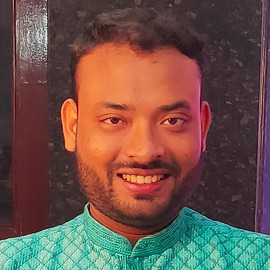Analog quantum simulation and universal dynamics of the Sachdev-Ye-Kitaev model
Abstract
The Sachdev-Ye-Kitaev (SYK) model [ 1, 2, 3] describes a strongly-correlated quantum many-body system with all-to-all disordered interactions. From the condensed-matter perspective, it provides a phenomenological description of strange metals which exhibit non-Fermi liquid behaviors [ 4]. On the other hand, the model is found to exhibit maximal quantum chaos by saturating the Maldacena-Shenker-Stanford bound for the quantum Lyapunov exponent of out-of-time-order-correlators [ 5]. The SYK model is also of great interest from a cosmological point-of-view as it manifests the characteristics of a quantum theory which is holographically dual to black holes with two-dimensional anti-de Sitter horizons [ 1]. Motivated by these rich features, we present a proposal [ 6] for the analog quantum simulation of the SYK model in a table-top cavity QED experiment consisting of a cloud of fermionic atoms interacting with the eigenmodes of an optical cavity [ 7]. We theoretically show how effective dynamics arise in this many-body system which are of the SYK $q=4$ form, i.e., all-to-all two-body interactions with randomly distributed amplitudes. We compare and contrast the spectral properties of the effective Hamiltonian to those of the theoretical SYK model. Further, we present a numeric study of universal dynamics (initial state independence) of equal-time correlators after global quenches into the SYK model [ 8, 9]. Through large parts of the evolution, these universal dynamics are well approximated by a Gaussian decay, which we show to be described well by an effective master equation for the disorder-averaged SYK dynamics. Our work provides a stepping-stone for the realisation of the SYK model, thereby making the complex dynamics of this strongly correlated system accessible in the laboratory. Not only does this provide the enticing prospect of studying the many unique properties of this model, but also of other strongly correlated variations along the way.
[1] S. Sachdev, Bekenstein–Hawking Entropy and Strange Metals, Phys. Rev. X 5, 041025 (2015).
[2] A. Kitaev, A simple model of quantum holography, Talks given at “Entanglement in Strongly-Correlated Quantum Matter,” (Part 1, Part 2), KITP (2015).
[3] J. Maldacena and D. Stanford, Remarks on the Sachdev-Ye-Kitaev model, Phys. Rev. D 94, 106002 (2016).
[4] D. Chowdhury, A. Georges, O. Parcollet and S. Sachdev, Sachdev-Ye-Kitaev Models and Beyond: A Window into Non-Fermi Liquids, Rev. Mod. Phys. 94, 035004 (2022).
[5] J. Maldacena, S. H. Shenker, and D. Stanford, A bound on chaos, J. High Energ. Phys. 2016, 106 (2016).
[6] P. Uhrich, S. Bandyopadhyay, N. Sauerwein, J. Sonner, J. Brantut, P. Hauke, A cavity quantum electrodynamics implementation of the Sachdev-Ye-Kitaev model, arXiv:2303.11343 [quant-ph] (2023).
[7] N. Sauerwein, F. Orsi, P. Uhrich, S. Bandyopadhyay, F. Mattiotti, T. Cantat-Moltrecht, G. Pupillo, P. Hauke, J.-P. Brantut, Engineering random spin models with atoms in a high-finesse cavity, Nat. Phys. 19, 1128–1134 (2023).
[8] S. Bandyopadhyay, P. Uhrich, A. Paviglianiti, and P. Hauke, Universal equilibration dynamics of the Sachdev-Ye-Kitaev model, Quantum 7, 1022 (2023).
[9] A. Paviglianiti, S. Bandyopadhyay, P. Uhrich, P. Hauke, Absence of Operator Growth in the Sachdev-Ye-Kitaev Model for Average Equal-Time Observables, Journal of High Energy Physics 2023, 126 (2023).
